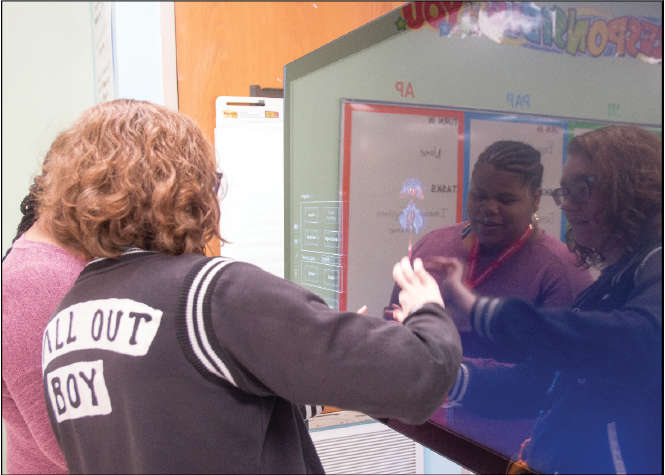CAMDEN — By BRADLY GILL
Staff Writer
Entering freshmen in Camden Fairview Biomedical Science courses have a very important mission with their first class. They’re tasked with solving the death of a 38 year old Hispanic female.
Don’t worry though, the person never really lived at all.
In the introductory course, Principles of Biomedical Science, students explore concepts of biology and medicine to determine factors that led to the death of a fictional person. Students examine autopsy reports, medical history and explore medical treatments that might have prolonged the persons life.
The next course, Human Body Systems involves students examining the human body systems as they explore identity, power, movement, protection and homeostasis in the body. The students are also investigators in another medical mystery by matching, once again, fictional skeletal remains to the profile of a missing person.
Juniors and seniors class members study Medical Interventions where they study the Smith family and learn about the prevention diagnosis and treatments of diseases.
A pamphlet for the course states, “Students explore how to detect and fight infection; screen and evaluate the code in human DNA; evaluate cancer treatment options; and prevail when the organs begin to fail. Through real world cases, students are exposed to a range of interventions related to immunology, surgery, genetics, pharmacology, medical devices, and diagnostics.”
Finally all the years of study are culminated in Biomedical Innovations, a senior level course where the innovators of tomorrow work with a mentor form a university, hospital or industry and delve into clinical medicine, physiology, biomedical engineering and public health.
In the corner of the BioMed classroom stands an object that looks like an oversized Ipad, but contains at least two humans worth of information.
The Anatomage table contains information from the Visible Human project, which according to the National Library of medicine has created publicly-available complete, anatomically detailed, three-dimensional representations of a human male body and a human female body. Specifically, the VHP provides a public-domain library of cross-sectional cryosection, CT, and MRI images obtained from one male cadaver and one female cadaver. The Visible Man data set was publicly released in 1994 and the Visible Woman in 1995.
The male cadaver is from Joseph Paul Jernigan, a 38-year-old Texas murderer who was executed by lethal injection on August 5, 1993. At the prompting of a prison chaplain he had agreed to donate his body for scientific research or medical use, without knowing about the Visible Human Project.
The 59-year-old female donor remains anonymous. In the press, she has been described as a Maryland housewife who died from a heart attack and whose husband requested that she be part of the project.
Anatomage.com states, “The Freehand Dissection Tool enables users to make incisions in any way or shape anywhere on the cadaver and remove structures layer-by-layer, and structure-by-structure. Instructors can simulate surgical cuts and provide a more dynamic teaching environment. Identify and isolate specific structures from an intuitive categorized list of systems, making Table Alpha a valuable anatomy learning solution.”
A 2018 news release from Camden Fairview states, “Table Alpha comes with both full body male and female anatomy images at 0.4mm to 0.1mm high resolution, allowing for the viewing of structures such as small nerves or blood vessels that are difficult to see by any other means. The images are from non-chemically treated cadavers with color and shape preserved. Also, with over a dozen animal scans included in Table Alpha, students can dissect and explore animal cases. Over 2,300 anatomical structures are fully annotated for both male and female cadavers. Unlike with traditional cadavers, a mistake in the dissection process using the Anatomage table can be undone easily.”
“With their fingers, students can rotate the virtual body and make incisions in any direction. Students can also scroll through the plane of the cut and see the details of the internal structures or cut again to further explore the anatomy. CFHS Biomedical Science students have the opportunity to explore what various wounds look like internally as well as externally. Students may study every human body system simultaneously or may isolate systems to view individually. One especially engaging feature of the Table Alpha is the ability to see diseased or damaged structures in addition to healthy structures. For example, students can compare the lungs of both a healthy individual and individual affected by cystic fibrosis.”
Hannah O’Dell, instructor for the BioMed courses, has a biology and chemistry degree. She said the course allows students to gain a better sense of identity, something that runs more than skin deep, literally.
“They don’t understand. They think their face is just their identity. They don’t understand the functioning and all those different canals that run through there. And why you feel puffy when you have that sinus infections,” she said.
She also said the students learn important anatomy lessons.
“One girl had taken off all of the skin on the head and so she just saw the muscles and she asked ‘Why is he smiling?’ I said, ‘What keeps you from smiling?’ You don’t show your teeth, but without your skins not there your teeth are showing. It just blew her mind,” she said. “It’s phenomenal. When you see all this is just makes it come to life.”
“They have more confidence in themselves, so they’ve been around things like this. So, when they get to college they aren’t intimidated by those professors, they’re not as intimidated by classmates maybe coming from larger school, she said.
O’Dell said one of the favorite elements of the class involve the students wearing lab coats. It gathered so much popularity among students that they wore them on days when the ROTC students would wear their uniforms.

